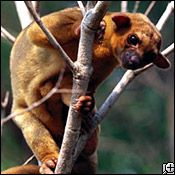This arboreal species, also known as the honey bear (a reference to its golden fur, not to its taste for honey), has a prehensile tail like the binturong.
An agile climber, it uses its tail as a fifth limb, freeing up its hands to hold food items.
Advertisement
It spends most of its days sleeping or resting inside a hollow tree, coming out only at night to forage.
Its diet consists of insects, small vertebrates such as birds, fruit, and nectar, which it laps up with its long tongue.
When the kinkajou is attacked, it fights back, grasping the predator with its limbs and tail and repeatedly biting with its strong canines.
Advertisement
